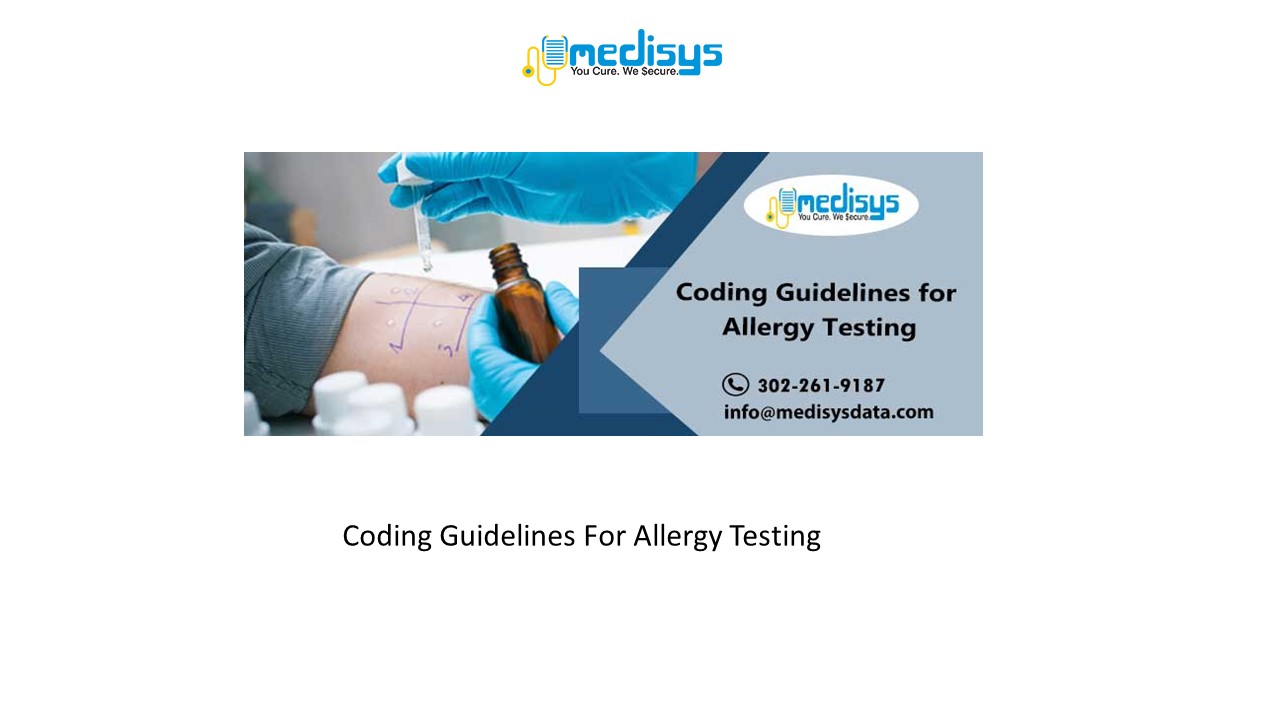Coding Guidelines For Allergy Testing - PowerPoint PPT Presentation
Title:
Coding Guidelines For Allergy Testing
Description:
Running an allergy practice can be exhausting and as allergy coding offers unique set of challenges. The key to establishing and maintaining an active, financially thriving allergy practice lies in a thorough understanding of the current reimbursement system and allergy coding guidelines. In this article, we shared coding guidelines for allergy testing which will help to receive accurate reimbursement from various payers. – PowerPoint PPT presentation
Number of Views:5
Title: Coding Guidelines For Allergy Testing
1
Coding Guidelines For Allergy Testing
2
Coding Guidelines For Allergy Testing
Running an allergy practice can be exhausting and
as allergy coding offers unique set of
challenges. The key to establishing and
maintaining an active, financially thriving
allergy practice lies in a thorough understanding
of the current reimbursement system and allergy
coding guidelines. In this article, we shared
coding guidelines for allergy testing which will
help to receive accurate reimbursement from
various payers. Allergy testing is the first step
in the immunotherapy process taken by a physician
towards tackling the patients allergies. Allergy
testing will include the performance, reading,
and evaluation of mucous membrane and cutaneous
testing, as well as an evaluation of patient
history including immunology. It will also
include the physical examination which decides on
antigens which are to be used, and a complete
interpretation of all results. Allergy testing is
always covered provided that clinically
significant symptoms exist, and that traditional
therapies have already failed to achieve results.
When allergy testing is necessary, the preferred
method to use would be standard skin
testing. Coding Guidelines for Allergy
Testing Allergy testing is covered when
clinically significant symptoms exist and
conservative therapy has failed. Allergy testing
includes the performance, evaluation, and reading
of cutaneous and mucous membrane testing along
with the physician taking a history including
immunologic history, performing the physical
examination, deciding on the antigens to be used,
and interpreting results.
3
Coding Guidelines For Allergy Testing
Allergy testing cannot be performed on the same
day as allergy immunotherapy i.e., the two
different billing codes should not be reported
together. Although the diagnostic test may not be
performed by the physician, the results have to
be reported and interpreted by a
physician. Evaluation and management codes
reported with allergy testing is appropriate only
if a significant, separately identifiable E/M
service is performed. When appropriate, use
modifier 25 with the E/M code to indicate it as
a separately identifiable service. If E/ M
services are reported, medical documentation of
the separately identifiable service must be in
the medical record. Allergy coding for testing
services involves the use of codes 95004 through
95078 which are all established codes in the MFPS
database as single tests. This means that the
frequency of the same test performed on the same
patient must be documented on the allergy billing
claim. For example, if an allergist performs 10
intracutaneous tests, the clinically appropriate
allergy billing code would be documented along
with a 10 in the units field to indicate that
ten units of the same test were conducted. The
total payment for reimbursement would be
calculated by multiplying the number of units of
the test by the payment for one test.
4
Coding Guidelines For Allergy Testing
- In addition, the interpretation and reporting of
the tests are included as part of these testing
codes. E/M service codes may be charged in
conjunction with allergy coding if the service is
significant and separately identifiable. In such
cases, modifier 25 is applied. However, if the
history and examination are only taken to enable
testing, the EM code cannot be billed
separately. - Non-Covered Services
- Sublingual intracutaneous and subcutaneous
provocative and neutralization testing and
neutralization therapy for food allergies are
excluded from coverage because available evidence
does not show that these tests and therapies are
effective. - Challenge ingestion food testing has not been
proven to be effective in the diagnosis of
rheumatoid arthritis, depression, or respiratory
disorders. Accordingly, its use in the diagnosis
of these conditions is not reasonable and
necessary and no program payment is made for this
procedure when it is so used. - Cytotoxic leukocyte tests for food allergies are
excluded from the coverage because available
evidence does not show that these tests are safe
and effective. - There is no denying that while you provide care
to your patients, you also need to focus on the
patient care rather than coding and
administrative aspect of your practice.
Unfortunately, most medical schools and colleges
provide little to no training on managing these
functions. However, you can outsource your
allergy and immunology services billing to
Medisys Data Solutions to accurate coding. To
know more about our billing and coding services,
contact us at info_at_medisysdata.com / 302-261-9187
5
(No Transcript)

